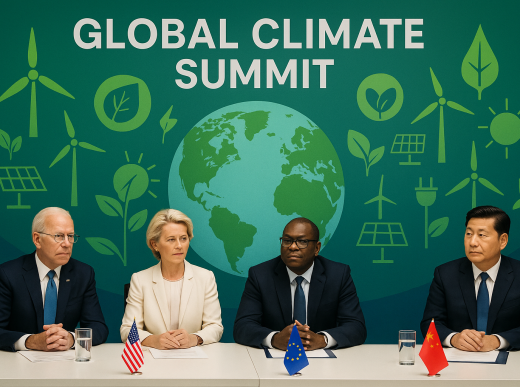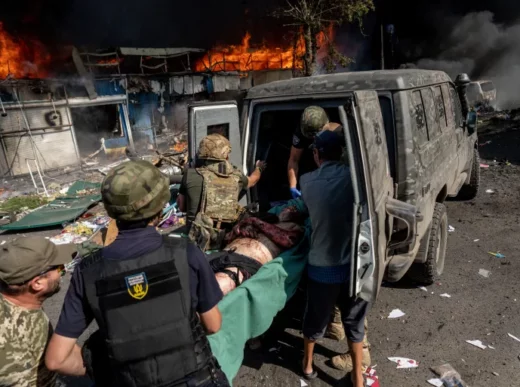By Christopher Marshall
WASHINGTON D.C. – The September 7, 2025 Russian assault on Ukraine’s Cabinet of Ministers building represents more than a military escalation—it marks a critical inflection point in the political and diplomatic dimensions of a conflict that has fundamentally reshaped global power dynamics. As the largest aerial attack since the war began, involving 810 drones and 13 missiles, this unprecedented assault on the seat of Ukrainian democracy carries profound implications for international relations, Western alliance cohesion, and the future trajectory of the conflict.
The targeting of Ukraine’s primary government building for the first time since the war began signals a deliberate Russian strategy to undermine not just Ukraine’s military capabilities, but the very foundations of its democratic governance. This escalation comes at a moment when international attention has been divided among multiple global crises, testing the resolve of Western allies and the sustainability of long-term support for Ukraine’s defense.
From a strategic perspective, the timing and scale of this attack suggest a calculated Russian gambit to exploit perceived weaknesses in Western resolve while demonstrating Moscow’s continued capacity for large-scale military operations. The political ramifications extend far beyond the immediate damage to government infrastructure, touching on fundamental questions about deterrence, alliance solidarity, and the future of the international order.
The Strategic Calculus Behind the Escalation
Putin’s Political Messaging Through Military Action
The decision to target Ukraine’s Cabinet building represents a significant escalation in Russian political warfare strategy. By striking at the symbolic heart of Ukrainian democracy, Moscow is sending multiple messages simultaneously: to Ukraine’s leadership about their vulnerability, to Western allies about the costs of continued support, and to domestic Russian audiences about the regime’s strength and determination.
This attack pattern aligns with established Russian doctrine that views political warfare as inseparable from military operations. The Kremlin’s strategy has consistently sought to achieve political objectives through military pressure, and the Cabinet building attack represents the most direct assault on Ukrainian political institutions since the conflict began.
The timing of the attack, coming as international attention has shifted to other global issues, suggests Russian calculations about Western attention spans and political will. Moscow appears to be testing whether sustained pressure can erode international support for Ukraine, particularly as domestic political considerations in Western capitals compete with foreign policy priorities.
“This attack represents Putin’s most direct challenge to the principle that democratic institutions are off-limits in modern warfare. It’s a deliberate provocation designed to test Western resolve and Ukrainian resilience simultaneously.” – Christopher Marshall
The scale of the attack—810 drones representing the largest swarm assault in military history—also serves as a demonstration of Russian technological capabilities and military-industrial capacity. This display of force is intended to counter narratives about Russian military degradation and resource constraints, projecting strength at a moment when Moscow faces increasing international isolation.
Ukrainian Political Resilience Under Fire
President Volodymyr Zelensky’s response to the Cabinet building attack has been carefully calibrated to demonstrate both the seriousness of the escalation and Ukraine’s unwavering commitment to democratic governance. By conducting his daily address from the damaged government building, Zelensky transformed a symbol of vulnerability into a demonstration of resilience and defiance.
The Ukrainian political response has emphasized continuity of government operations despite the physical damage to key infrastructure. This messaging is crucial for maintaining both domestic morale and international confidence in Ukraine’s governmental stability. The ability to maintain essential governmental functions under direct attack serves as a powerful counter-narrative to Russian attempts at political intimidation.
Ukraine’s political leadership has also used the attack to renew calls for additional air defense systems and long-range weapons capabilities. The targeting of government buildings provides new justification for requests that had previously faced resistance from some Western allies concerned about escalation dynamics.
The attack has strengthened Ukrainian arguments for expanded military capabilities, particularly regarding long-range strike systems that could target Russian military infrastructure. The political logic is clear: if Russia is willing to target the seat of Ukrainian democracy, Ukraine should have the capability to respond against Russian military and governmental targets.
Western Alliance Dynamics and Strategic Responses
NATO’s Evolving Calculus
The Cabinet building attack has prompted intense discussions within NATO about the alliance’s response framework and the boundaries of acceptable escalation. While the attack targeted Ukrainian rather than NATO territory, the unprecedented nature of the assault has raised questions about deterrence effectiveness and the need for more robust defensive measures.
NATO Secretary-General Jens Stoltenberg’s immediate condemnation of the attack as a “blatant violation of international law” reflects the alliance’s recognition that this escalation crosses new red lines in terms of targeting civilian governmental infrastructure. The announcement of expedited air defense system deliveries represents a tactical response, but broader strategic questions remain unresolved.
The attack has also highlighted divisions within the alliance regarding the provision of long-range weapons systems to Ukraine. While some members view the Cabinet building assault as justification for removing restrictions on Ukrainian strike capabilities, others remain concerned about escalation risks and the potential for direct NATO-Russia confrontation.
The political dynamics within NATO are complicated by domestic considerations in member countries, where public support for Ukraine remains strong but faces pressure from economic concerns and war fatigue. The Cabinet building attack serves as a reminder of the stakes involved, potentially strengthening arguments for sustained support while also highlighting the risks of prolonged confrontation.
U.S. Political Response and Strategic Implications
The Biden administration’s response to the Cabinet building attack has been swift and comprehensive, with Secretary of State Antony Blinken’s characterization of the assault as “an unconscionable escalation” setting the tone for broader U.S. policy adjustments. The announcement of additional sanctions against Russia and accelerated military aid to Ukraine reflects the administration’s assessment that this escalation requires a proportional response.
The political implications within the United States are significant, particularly as the 2026 midterm elections approach. The attack provides new ammunition for those advocating stronger support for Ukraine while also raising concerns among those worried about the costs and risks of prolonged confrontation with Russia.
Congressional response has been largely bipartisan in condemning the attack, but underlying tensions remain about the scope and duration of U.S. commitments to Ukraine. The Cabinet building assault may strengthen arguments for sustained support, but it also highlights the open-ended nature of the conflict and the potential for further escalation.
The attack has also renewed discussions about the effectiveness of current sanctions regimes and the need for additional economic pressure on Russia. The targeting of democratic institutions provides new justification for expanded sanctions, particularly targeting Russian governmental and military leadership directly responsible for the escalation.
International Diplomatic Ramifications
European Union Response and Unity Challenges
The European Union’s response to the Cabinet building attack has been complicated by internal divisions about the appropriate level of response and the long-term sustainability of current support levels. European Commission President Ursula von der Leyen’s description of the attack as “a direct attack on the foundations of democratic governance” reflects the EU’s recognition of the broader implications beyond immediate military concerns.
The attack has accelerated discussions about additional military aid packages, but also highlighted the challenges of maintaining unity among 27 member states with varying levels of commitment to Ukrainian support. Some members view the escalation as justification for increased aid, while others express concern about the economic and political costs of prolonged confrontation.
The targeting of governmental infrastructure has particular resonance within the EU, where democratic institutions are viewed as fundamental to the European project. This symbolic dimension may strengthen European resolve, but practical constraints regarding military production capacity and economic resources remain significant challenges.
The attack has also complicated EU discussions about long-term reconstruction planning for Ukraine. The targeting of governmental buildings raises questions about the security of future investments and the timeline for potential Ukrainian EU membership, issues that have significant political implications across the bloc.
Global South Reactions and Non-Aligned Positioning
The Cabinet building attack has elicited varied responses from Global South nations, many of which have maintained neutral or non-aligned positions regarding the Ukraine conflict. The targeting of governmental infrastructure has been condemned by some as a violation of international norms, while others have called for renewed diplomatic efforts to end the conflict.
The attack has highlighted the challenges facing non-aligned nations in maintaining neutrality as the conflict escalates. The unprecedented nature of the assault makes it difficult to maintain equivalence between the parties, potentially pushing some previously neutral nations toward more explicit condemnation of Russian actions.
China’s response to the attack has been particularly significant, given Beijing’s role as a potential mediator and its complex relationship with Moscow. The targeting of governmental buildings complicates Chinese efforts to maintain balanced rhetoric about the conflict, as such actions are difficult to justify under international law.
The attack may also influence Global South perceptions of the conflict’s trajectory and the likelihood of negotiated settlement. The escalation suggests that diplomatic solutions remain distant, potentially affecting calculations about engagement with peace initiatives and mediation efforts.
Domestic Political Implications Within Ukraine
Strengthening National Unity
The Cabinet building attack has had a galvanizing effect on Ukrainian domestic politics, strengthening national unity at a moment when war fatigue might otherwise be expected to create political divisions. The targeting of the seat of government has been widely interpreted as an attack on Ukrainian democracy itself, transcending partisan political considerations.
President Zelensky’s approval ratings, which had shown some decline in recent months, have received a boost from his handling of the crisis and his symbolic decision to address the nation from the damaged government building. This demonstration of leadership under fire has reinforced his position as a wartime leader and strengthened his political mandate for continued resistance.
The attack has also strengthened arguments for expanded presidential powers and emergency authorities that might otherwise face political opposition. The direct targeting of governmental infrastructure provides clear justification for extraordinary measures to protect democratic institutions and maintain governmental continuity.
Opposition political parties have largely rallied around the government’s response to the attack, demonstrating the continued strength of national unity in the face of external aggression. This political cohesion is crucial for maintaining the domestic support necessary for sustained resistance efforts.
Challenges to Democratic Governance Under Siege
While the attack has strengthened national unity, it has also highlighted the challenges of maintaining democratic governance under conditions of active warfare. The damage to the Cabinet building has forced the relocation of some governmental functions, creating practical challenges for administrative continuity and democratic oversight.
The attack has also raised questions about the security of democratic institutions and the measures necessary to protect governmental operations from future attacks. These security considerations must be balanced against the need to maintain transparency and public access that are fundamental to democratic governance.
The targeting of governmental infrastructure has implications for Ukraine’s post-war democratic development, as the experience of governing under siege may influence institutional design and security protocols for years to come. The challenge will be maintaining democratic norms while adapting to the realities of ongoing security threats.
Strategic Implications for Conflict Resolution
Impact on Diplomatic Initiatives
The Cabinet building attack has significantly complicated ongoing diplomatic efforts to find a negotiated settlement to the conflict. The targeting of governmental infrastructure sends a clear message about Russian intentions and makes it more difficult for Ukrainian leadership to engage in peace negotiations from a position that might be perceived as weakness.
The attack has also affected international mediation efforts, as the unprecedented escalation raises questions about Russian commitment to diplomatic solutions. Potential mediators must now account for the possibility of further escalation targeting civilian and governmental infrastructure, complicating efforts to create conditions conducive to negotiation.
The timing of the attack, coming as some international observers had suggested renewed diplomatic possibilities, appears calculated to disrupt peace initiatives and demonstrate Russian military capabilities. This tactical use of escalation to influence diplomatic dynamics is a classic element of Russian strategic culture.
The attack may also influence Ukrainian negotiating positions, as the targeting of democratic institutions strengthens arguments against territorial concessions or other compromises that might be perceived as rewarding aggression against civilian governance structures.
Long-term Strategic Trajectory
The Cabinet building attack suggests that the conflict is entering a new phase characterized by direct targeting of governmental and civilian infrastructure. This escalation pattern indicates that Russia is prepared to expand the scope of legitimate targets, potentially leading to further attacks on civilian institutions and infrastructure.
The attack also demonstrates continued Russian military capabilities despite reports of equipment shortages and personnel challenges. The ability to conduct such a large-scale coordinated assault suggests that Russia retains significant offensive capacity and is prepared to use it for political as well as military objectives.
The international response to the attack will likely influence Russian calculations about future escalation. A strong, coordinated response may deter further attacks on civilian infrastructure, while a weak response could encourage additional escalation targeting democratic institutions and civilian governance structures.
The attack has also implications for post-conflict reconstruction and governance, as the targeting of governmental buildings highlights the challenges of rebuilding democratic institutions in a security environment that may remain threatening for years to come.
Implications for U.S. Foreign Policy and Global Strategy
Deterrence and Escalation Management
The Cabinet building attack presents significant challenges for U.S. deterrence strategy and escalation management. The unprecedented nature of the assault requires a response that demonstrates resolve without triggering further escalation, a delicate balance that has implications for broader U.S.-Russia relations.
The attack also highlights the limitations of current deterrence mechanisms, as existing sanctions and military aid have not prevented this escalation. This reality requires reassessment of deterrence strategies and consideration of additional measures that might be more effective in preventing future attacks on civilian infrastructure.
The U.S. response must also consider the broader implications for international law and the protection of civilian institutions in warfare. The targeting of governmental buildings sets a dangerous precedent that could be replicated in other conflicts, requiring a strong international response to maintain established norms.
The attack has implications for U.S. alliance relationships, as the response will be closely watched by allies and partners as an indicator of American commitment to defending democratic institutions and international law. A weak response could undermine U.S. credibility and alliance cohesion.
Long-term Strategic Competition
The Cabinet building attack is best understood within the broader context of U.S.-Russia strategic competition and the contest over the future of the international order. The targeting of democratic institutions represents a direct challenge to the values and principles that underpin the liberal international system.
The attack also has implications for U.S. strategy toward other authoritarian powers, particularly China, which is closely watching the international response to Russian escalation. The precedent set by the response to this attack may influence Chinese calculations about the costs and risks of aggressive actions in other theaters.
The conflict in Ukraine has become a test case for the resilience of democratic institutions and the effectiveness of international law in protecting civilian governance structures. The outcome of this test will have implications for global stability and the future of democratic governance worldwide.
The U.S. response must therefore consider not only the immediate tactical requirements of supporting Ukraine, but also the broader strategic implications for maintaining international order and deterring future challenges to democratic institutions and civilian governance structures.
Conclusion: A Defining Moment for Democratic Resilience
The September 7 attack on Ukraine’s Cabinet of Ministers building represents a defining moment in the conflict that extends far beyond immediate military considerations. The targeting of the seat of Ukrainian democracy constitutes a direct challenge to the principles of civilian governance and international law that underpin the modern international system.
The political implications of this escalation will reverberate through international relations for years to come, influencing alliance relationships, deterrence strategies, and the broader contest between democratic and authoritarian governance models. The response to this attack will be closely watched as an indicator of international commitment to protecting democratic institutions and civilian governance structures.
For Ukraine, the attack represents both a challenge and an opportunity—a challenge to maintain democratic governance under direct assault, and an opportunity to demonstrate the resilience of democratic institutions in the face of authoritarian aggression. The Ukrainian response has thus far emphasized continuity and defiance, transforming a symbol of vulnerability into a demonstration of democratic resilience.
The international community’s response will determine whether this attack marks the beginning of a new phase of escalation targeting civilian institutions, or whether strong deterrent measures can prevent further attacks on democratic governance structures. The stakes extend far beyond Ukraine, encompassing fundamental questions about the future of international law, civilian protection, and democratic governance in an increasingly contested world.
As the conflict continues to evolve, the Cabinet building attack will be remembered as a moment when the international community was forced to confront the reality that democratic institutions themselves have become targets in modern warfare. The response to this challenge will shape not only the trajectory of the Ukraine conflict, but the broader future of democratic governance and international stability in the 21st century.
The path forward requires sustained commitment to defending democratic institutions, strengthening international law, and demonstrating that attacks on civilian governance structures will be met with decisive responses that uphold the principles of democratic governance and civilian protection. The alternative—accepting the targeting of democratic institutions as a legitimate tactic of warfare—would represent a fundamental shift in international norms with implications that extend far beyond the current conflict.
Christopher Marshall is a senior policy analyst specializing in international security and democratic governance. His analysis focuses on the intersection of military strategy and political objectives in contemporary conflicts. This analysis is part of PRAI News’ comprehensive coverage of international political developments and their strategic implications.
















